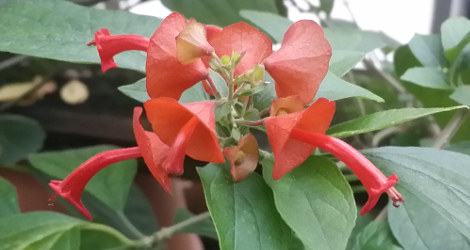Accession Data:
Holmskioldia sanguinea Retz.
- Common Name: Chinese Hat
- Family: Lamiaceae Lindl.
- Description: Shrub, straggling or liana up to 10-20 ft high. Bark dark brown or grey, smooth, peeling off in to narrow papery strips, branches and branchlets slender, acutely quadrangular, pubescent when young and glabrous when mature, nodes annulate. Leaves simple, opposite, broadly ovate-elliptic or broadly lanceolate, 4-11 x 2.5-7, base rounded to subcordate, margins finely crenate-serrate, apex acuminate or abruptly cuneate, chartaceous, lateral veins 4-7 on either side of the midrib, minutely pubescent above, pubescent on veins and gland-dotted beneath, ascending, margins arcuate, petiole slender, canaliculated about 1-3 cm long, exstipulate. Inflorescence cymose racemes, axillary and terminal, about 5 cm long, subtending petiole, bract ovate or elliptic, apex acute. Flowers bisexual, red, glabrous, pedicel about 1 mm long, calyx saucer shaped, minutely 5 toothed, red, yellow, orange, membranous, minutely pubescent or glabrous, about 2.5 cm long, corolla infundibular, 5 lobed, lobes obtuse, red, orange, or usually the same colour of the calyx, about 4 mm long, corolla tube narrow, cylindric, slightly ampliate towards the apex, pubescent, about 2 cm long, and 0.5 cm wide, stamens 4 didynamous to subequal, exserted, filaments slender, slightly hairy, about 1.5-2.5 cm long, anther oblong or ovoid, white, ovary conical, glabrous, style slender, filiform, almost same coloured as the calyx and corolla, about 1.5-2.5 cm long, stigma bi-lobed. Fruit drupe subglobose, about 1 cm in diameter, deeply 4 lobed at the apex, splitting into 4 pyrenes, seeds 1-4, verrucose, fruiting calyx accrescent, endocarp hard.4
- Culture: Its long, trailing canes make it ideal for espaliering. Rampant growth can be contained by pruning after flowering and old canes can be removed. There are also yellow- and bronze-flowered forms.
- USDA Zone: 10-11
Accession Data:
- Accession # 200500019
- Source: Joan Leonard - Ohio State
- Accession Date: 04-07-2005
- Bench: 1207 - AUS:East Bench NC
- Currently: active - healthy
- Qty: 3 confirmed on 07-01-2025
Classification:
- Division: Magnoliophyta
- Class: Magnoliopsida
- SubClass: euasterid I
- Order: Lamiales
- SubOrder:
- Family: Lamiaceae
- SubFamily: Scutellarioideae
- Tribe:
- SubTribe:
Flowering Data:
This accession has been observed in bloom on:| Year | Jan | Feb | Mar | Apr | May | Jun | Jul | Aug | Sep | Oct | Nov | Dec | ||||||||||||||||||||||||||||||||||||||||
|---|---|---|---|---|---|---|---|---|---|---|---|---|---|---|---|---|---|---|---|---|---|---|---|---|---|---|---|---|---|---|---|---|---|---|---|---|---|---|---|---|---|---|---|---|---|---|---|---|---|---|---|---|
| 2025 | ||||||||||||||||||||||||||||||||||||||||||||||||||||
| 2024 | ||||||||||||||||||||||||||||||||||||||||||||||||||||
| 2023 | ||||||||||||||||||||||||||||||||||||||||||||||||||||
| 2022 | ||||||||||||||||||||||||||||||||||||||||||||||||||||
| 2021 | ||||||||||||||||||||||||||||||||||||||||||||||||||||
| 2020 | ||||||||||||||||||||||||||||||||||||||||||||||||||||
| 2019 | ||||||||||||||||||||||||||||||||||||||||||||||||||||
| 2018 | ||||||||||||||||||||||||||||||||||||||||||||||||||||
| 2017 | ||||||||||||||||||||||||||||||||||||||||||||||||||||
| 2016 | ||||||||||||||||||||||||||||||||||||||||||||||||||||
| 2015 | ||||||||||||||||||||||||||||||||||||||||||||||||||||
| 2014 | ||||||||||||||||||||||||||||||||||||||||||||||||||||
| 2013 | ||||||||||||||||||||||||||||||||||||||||||||||||||||
| 2012 | ||||||||||||||||||||||||||||||||||||||||||||||||||||
| 2011 | ||||||||||||||||||||||||||||||||||||||||||||||||||||
| 2010 | ||||||||||||||||||||||||||||||||||||||||||||||||||||
| 2009 | ||||||||||||||||||||||||||||||||||||||||||||||||||||
| 2008 | ||||||||||||||||||||||||||||||||||||||||||||||||||||
| 2007 | ||||||||||||||||||||||||||||||||||||||||||||||||||||
| 2006 | ||||||||||||||||||||||||||||||||||||||||||||||||||||
| 2005 | ||||||||||||||||||||||||||||||||||||||||||||||||||||
References (internal):
- EEB Greenhouse Holdings native to: Assam / East Himalaya / India / Nepal / West Himalaya / Myanmar /
References (external):
- Botanica, Turner & Wasson, 1997, CD-ROM Version
- The Plant List (2013). Version 1.1. Last accessed on Thursday, August 17, 2017.
- WCSP (2015). World Checklist of Selected Plant Families. Facilitated by the Royal Botanic Gardens, Kew. Last accessed on Thursday, August 17, 2017.
- Holmskioldia sanguinea at India Biodiversity. Last accessed on Thursday, August 17, 2017.
data regenerated on Tue, 01 Jul 2025 11:33:14 -0400 [bcm v4.0]
Images:

Additional images for this accession:
Click on thumbnails to enlargeCurrent Accessions in the Lamiaceae
Subfamily Ajugoideae
- Clerodendrum nutans


- Clerodendrum speciosissimum



- Clerodendrum thomsoniae



- Faradaya splendida

- Petraeovitex bambusetorum


- Teucrium chamaedrys

- Teucrium fruticans

Subfamily Lamioideae
Tribe Pogostemoneae
Subfamily Lamioideae
Tribe Stachydeae
Subfamily Nepetoideae
Tribe Mentheae
- Lycopinae: Lycopus europaeus

- Menthinae: Thymus kotschyanus

- Prunellinae: Prunella grandiflora

- Salviinae: Rosmarinus officinalis


- Salviinae: Salvia discolor

- Salviinae: Salvia microphylla


- Salviinae: Salvia officinalis


- Salviinae: Salvia pinguifolia


Subfamily Nepetoideae
Tribe Ocimeae
- Lavandulinae: Lavandula angustifolia


- Lavandulinae: Lavandula dentata

- Ociminae: Ocimum tenuiflorum


- Plectranthinae: Coleus scutellarioides

- Plectranthinae: Coleus scutellarioides

- Plectranthinae: Plectranthus amboinicus

- Plectranthinae: Plectranthus neochilus


- Plectranthinae: Plectranthus saccatus


- Plectranthinae: Tetradenia riparia

Subfamily Prostantheroideae
Tribe Westringieae
Subfamily Scutellarioideae
- Holmskioldia sanguinea



- Scutellaria alpina


- Scutellaria argentata


- Scutellaria javanica


- Scutellaria purpurascens subsp. verecunda W/C

- Scutellaria tuberosa W/C

Subfamily Symphorematoideae
Subfamily Viticoideae
W/C = Wild Collected = indicates flowering in past 14 days
= indicates flowering in past 14 days
 = images available for this accession
= images available for this accession
 = map available for this accession
= map available for this accession
 = accession added within past 90 days
= accession added within past 90 days

